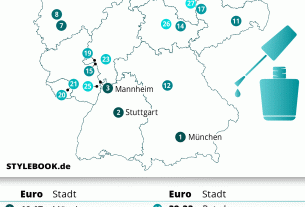
Intense black facial beauty products, jet-black toothpastes for a radiant smile: the triumph of activated charcoal products has been in full swing for some time. But few know that binchotan also has beneficial properties for health.
The name Kishu Binchotan sounds exotic and mysterious at first. This is activated charcoal and is now found in some cosmetic products. But the Japanese wonder weapon is said to be effective not only in the field of cosmetics, but also for indoor climate, water quality and health. Overrated or a true all-rounder? STYLEBOOK takes a closer look and talks to health expert and pharmacist Steffen Kuhnert.
How does white charcoal work?
Anyone who puts charcoal sticks into drinking water should know what exactly happens: “Activated charcoal has a large surface area and is therefore able to bind other substances to its surface (in medicine this is also referred to as adsorbent properties) and are therefore harmless.” the expert explains how it works. To serve as a filter material for water and air, white carbon emits negatively charged ions. Artisan binchotan is only activated during the manufacturing process (when it is cooked). In the last stage of the process, the coal is enriched with minerals from its own wood ash and concentrates them. At the end is the cloth covered with a thin white ash skin (hence the name binchotan, white charcoal). In this way, foreign substances in the air and water, such as chlorine or drug residues, can be filtered out.
Is it really healthy?
The expert sees no health risk in the use of pure activated carbon, but also does not see it as a huge improvement in drinking water. Kuhnert criticizes the claim that Binchotan improves quality, associating it with the fact that we don’t currently have healthy drinking water available: “In my opinion this is not the case.” In general, however, he notes that outdated internal plumbing could theoretically affect quality.
How to use Binchotan
Placed in water, the white carbon is said to act as a battery equipped with minerals. At the beginning, however, it must first be rinsed under running water to remove the dissolved remnants of the wood ash. Then put them in cold water and bring them to the boil for three minutes. Then let it dry. The activated charcoal should then work in a carafe of water for at least two to four hours. The indicative value is given with about 100 g of binchotan for 1 liter of water. When the water is gone, simply fill the container with charcoal. To reactivate the charcoal and, if necessary, sterilize it, you can boil it again for about a minute. Then let it dry again.
Binchotan for a better indoor climate
It does not crumble or blacken, it is as hard as iron and also beautiful to look at: it is not for nothing that Binchotan charcoal – 100% reusable and recyclable – can be used in addition to its function as a stylish accessory in the home water filter. Thanks to the charcoal, the room air should be freed from electromagnetic radiation. And in the peel of the fruit it absorbs ethylene gases produced by ripening and decomposition.
Activated carbon in medicine and food
In medicine, coal is administered as a drug against diarrhea or in case of poisoning. The effect is the same. Toxins, bacteria and toxins are bound by the activated charcoal, expelled and thus rendered harmless. Kuhnert explains why activated carbon is finding more and more followers also as food (in Japan, in addition to filtering water, it is used not only to cook rice, but also as an addition to meals): “In tap water, activated carbon should remove germs, pollutants such as heavy metals, suspended substances and possibly also bind drug residues and make them harmless. In addition, it releases minerals into the water. Together with vitamins and secondary plant substances, minerals are very important for our health.” .
Binchotan in cosmetics
Binchotan in gowns and masks
Binchotan can also prove to be a valuable ingredient in skin care. Due to its absorbent properties, it is often found in face masks or exfoliants. Excess sebum, dirt and make-up residues can be removed from the skin. Pores appear smaller and skin clearer. This is aided by the fine texture of Japanese activated charcoal, which can have an exfoliating effect on the skin.
Also interesting: Are chemical peels advisable in the summer?
Activated carbon in dental care
Whether in powder form, as a toothpaste or as a capsule, activated charcoal is often used in dental care. The reason for this is the alleged teeth whitening effect. The granular structure of activated carbon wears away the top layer of the tooth during cleaning, including discoloration. This causes the teeth to look visibly whiter. However, caution must be exercised here. With long-term use, activated charcoal not only removes discolouration, but also tooth enamel and ensures that the tooth surface is roughened. This in turn will allow plaque to settle on your teeth more easily in the future. For an effective application that does not damage your teeth, you should therefore take a look at the consistency of the product: the finer it is, for example in the form of toothpaste, the better. When it comes to dental care, you should stay away from coarse-grain activated charcoal products, such as powder or capsules that you can mix yourself.
Binchotan activated carbon: do I really need it?
A wonderful weapon from Japan or just some dubious lifestyle? The health expert remains vague: “Binchotan will not harm our health. Since our drinking water is generally of high quality, the health benefits are not obvious and are more likely related to the taste. Minerals are important for our health. However, whether Binchotan noticeably increases the mineralization of the water should be proven by the manufacturer through tests. I am quite critical of its suitability for daily use.” In other words: there is little to say, but nothing against, simply by trying the carbon rod.
source
- with the professional advice of health experts and pharmacists Steffen Kuhnert




